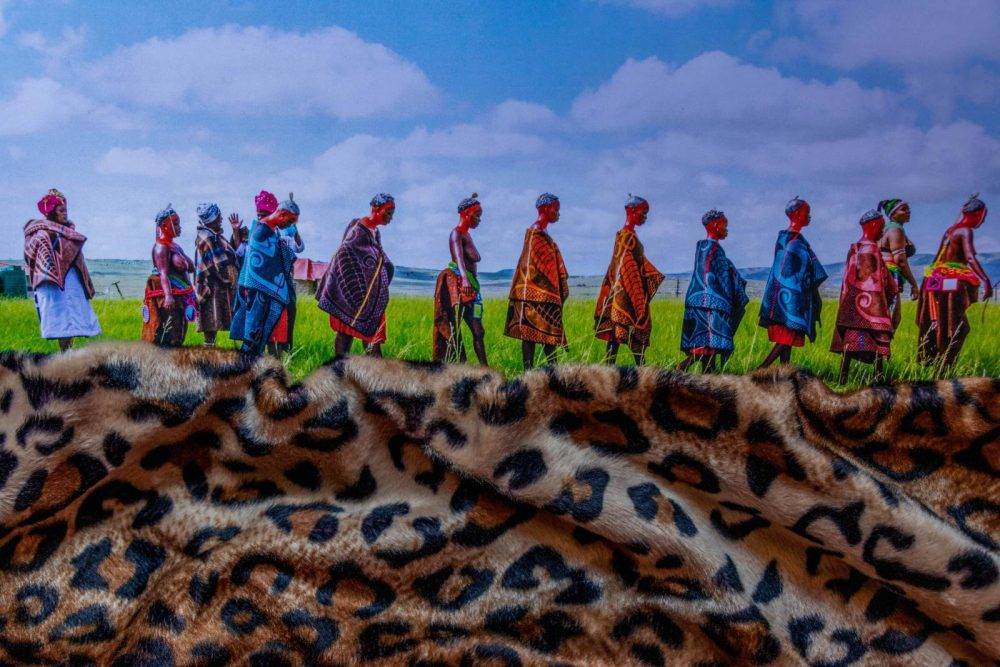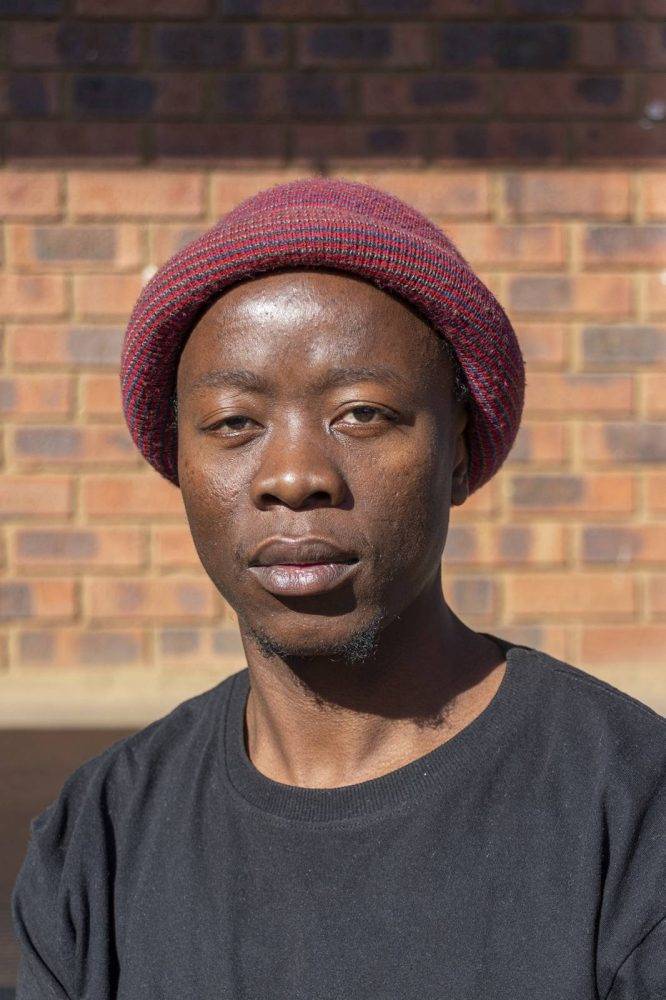Bomme, by Simphiwe Fuwe Molefe, can be viewed at the ‘I Put My Hand On My Chest To Feel My Heartbeat’ exhibition in Joburg. (Photo: Maribe Mokgobu)
Whenever I find myself in the position where someone asks, “What are you?” the natural response is to say, “I am Pedi.”
However, that is not the reality for many South Africans. Our identities are rarely singular, rarely confined to one language, one tradition, one way of being.
We are connected to many cultures, moulded by histories that extend beyond the rigid boundaries of classification.
If I had to answer truthfully, I would say, “I am South African.”
But even that response can be met with resistance — some find pride in belonging to a singular heritage, an unbroken lineage.
I come from many — and I belong to all of them. If you want specifics, my mother’s father is Tsonga from Mozambique, her mother is Zulu from Bergville, which shaped the foundation of my upbringing, and my father is Pedi.
It is with this layered understanding of identity that I step into I Put My Hand On My Chest To Feel My Heartbeat, an exhibition by the Thokoza photography initiative Of Soul and Joy at Constitution Hill in Johannesburg.
The ancestors of Constitution Hill must have decided I needed to be cleansed before stepping into the space, as rain baptised me on my way to the Women’s Prison, where the exhibition is taking place.
Once inside, I am met with a heartening sight — young people, some still in their school uniforms, huddled around the works, taking pictures, engaging with the art.
It makes me smile. South African documentary photography is often under-appreciated, yet here, in this historic space, the youth are not only witnessing it but also seeing themselves reflected in it.
There is a live band playing Three Little Birds by Bob Marley. I forget that I am wet and practically dying from a cold.
The walls are adorned with the works of 16 artists: Zwelibanzi Zwane, Xolani Ngubeni, Teboho Mabuya, Vuyo Mabheka, Tadiwa Mokono, Limnandi Paca, Lunathi Mngxuma, Siyabonga Mhlanga, Simphiwe Fuwe Molefe, Lehlohonolo Sigaba, Anele Ntshangase, Sibusiso Bheka, Thembinkosi Hlatshwayo, Tshepiso Mazibuko, Life Ngubeni and Sikelela Mdilikwana.
 Ditsojane by Simphiwe Fuwe Molefe can be viewed at the ‘I Put My Hand On My Chest To Feel My Heartbeat’
Ditsojane by Simphiwe Fuwe Molefe can be viewed at the ‘I Put My Hand On My Chest To Feel My Heartbeat’
exhibition in Joburg. (Photo: Maribe Mokgobu)
Each piece tells a deeply personal story — yet one that is undeniably universal to the South African experience.
I am immediately drawn to Molefe’s work, a series of collages that merge two seemingly different cultures — Zulu and Sotho — in a single landscape.
The images cut through the illusion of separation, challenging the notion that cultural identities are distinct and unyielding.
At the centre of his work lies a Basotho blanket, layered with imagery and meaning. On it, a mirror. A deliberate invitation to reflect, not just on the art, but on oneself. Standing in front of it, I see my own complexity mirrored back at me.
The Zulu and Basotho figures in his work do not stand apart, they coexist, not as separate entities but as parts of a greater whole. It is a South African story we don’t tell often enough — the interweaving of cultures, the inevitable fusion of identities.
I missed Molefe at the opening but I reached out to him later. On the phone, his voice carries the rich inflections of both Sotho and Zulu.
“The title of my work, Ungowakwethu Wena, comes from a Zulu phrase meaning, ‘You are one of us.’”
Often used as an affirmation of belonging, it is a powerful statement in a country where language and lineage can still act as dividing lines.
Molefe’s project was born out of personal experience.
 Simphiwe Fuwe Molefe. (Photo supplied)
Simphiwe Fuwe Molefe. (Photo supplied)
“I grew up in KwaZulu-Natal, in a place called Nquthu,” he explains. “People assumed I was Zulu because I spoke the language fluently. But I am Sotho.”
This assumption led him to question the fluidity of identity. What does it mean to belong? Is it language, lineage or location that determines it?
“Using my photography, I wanted to show that many Sotho people live in deep rural KZN and still practise their culture and heritage within a Zulu-dominated space,” he says.
“There’s no division, no ‘we are Zulu, and you are Sotho, so we must live separately’.”
He says his research shows there are very few other places in the province that have cultures coexisting as Sotho and Zulu people do in Nquthu.
His work does not attempt to erase differences but rather highlights the beauty in their coexistence.
I grew up in Tembisa, and I recognise the nuances Molefe speaks of. Our townships are mapped by cultural enclaves — Isithame has a large Tsonga community, Mashimong is known for its Pedi residents, Ndulweni is predominantly Zulu and Khalambazo home to Ndebele people.
Despite these divisions, multilingualism thrives. Moving between sections requires linguistic dexterity — not just for convenience but for safety, respect and a sense of belonging. Similar to what Molefe experienced in Nquthu.
Over generations, this constant interaction has led to a blending of cultures. Children of parents from different ethnic backgrounds inherit and embrace multiple identities, making them neither fully one nor the other, but something new.
Molefe’s work taps into this reality, capturing the organic fusion of cultures that has always existed in South Africa.
Lesole Tauatswala, the Creative Uprising Hub coordinator at Constitution Hill and the curator of the exhibition, sees a strong connection between Molefe’s work and the themes explored by the other artists.
“They use the places they come from to frame their identities,” he says. “Townships are often reduced to stereotypes — gusheshes, alcohol, violence — but they are as complex as any other space. There’s so much more happening.”
Tauatswala deliberately structured the exhibition to give each artist the space to tell their story.
“The title, I Put My Hand On My Chest To Feel My Heartbeat, is about artists responding to their emotions, their experiences,” he explains.
“It was important to centre that personal connection.”
For him, the exhibition is proof that South African documentary photography is in safe hands.
He hopes that the artists, especially the emerging ones, will gain more opportunities to exhibit their work beyond this space.
“I want them to travel to other communities, to teach others, to create archives of their communities,” he says.
“This exhibition should be a stepping stone, not the final destination.”
Molefe has received an overwhelming response to Ungowakwethu Wena: “The conversations it has sparked are about accepting the many parts of ourselves.”
He says a man came to him to tell him that is not how his name is spelt in Sesotho. This created a moment to speak about how language and spelling can be completely different, depending on where you come from.
The works create an opportunity to learn for everyone.
“There is no shame in saying I come from different people, different cultures,” Molefe says.
His work challenges the idea that identity is fixed, instead embracing its evolving nature.
It also highlights how geography shapes who we are — how moving through different spaces, speaking different languages and participating in different traditions all contribute to our sense of self.
“I want people to reflect on who they are,” he says. “There is power in knowing yourself.”
Standing in front of his work, I understand exactly what he means. I see myself. I see all of us.
The exhibition ends on 31 March.